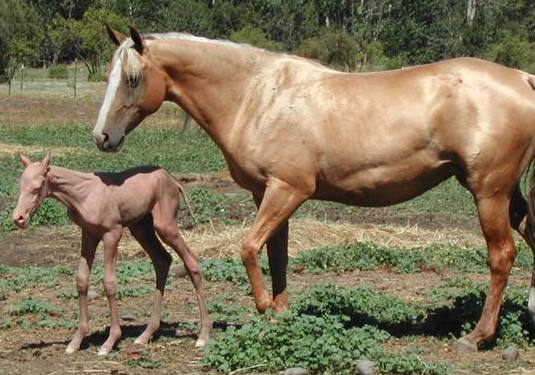There are several genetic diseases of concern to Akhal-Teke breeders. The genetic diversity of the breed is relatively low with an AVK of 30-50%, which raises concerns for dealing with an increase in carriers of these conditions, and even some risk of inbreeding depression. To date, there are no DNA tests for these conditions.

Naked Foal Syndrome or Hairless Foal Syndrome is most likely an autosomal, lethal recessive gene, though the exact inheritance pattern has not yet been verified. It appears to be similar in clinical signs, though not identical to junctional epidermolysis bullosa (JEB) found in the Belgian horse and another condition of a similar nature identified in the American Saddlebred.
The defect causes foals to be born without any hair coat, mane or tail. In some cases, the front teeth are in at birth or molars grow abnormally from normal jaws. Other symptoms include persistent diarrhea, frequent digestive disorders and laminitis-like, treatment-resistant rotation of the coffin bones in the hooves.
Due the lack of normal skin protection, secondary symptoms include scaly, dry and inflamed skin, as well as severe cases of sunburn in summer and frequent pulmonary infections during winter. NFS is always fatal, most foals die within weeks of birth, although some horses have survived up to the age of two years.
Early demise is usually caused by digestive problems, whereas older horses need to be humanely euthanized because of severe laminitis-induced pain. Cases were recorded within the Akhal-Teke breed as early as 1938. In spite of the breed’s limited population, naked foals have been born in every country in which the breed is represented, including the USA.
Some 35 carriers have been ascertained, including 943 Arslan, 736 Keymir, 2001 Mariula or 1054 Gilkuyruk, but the estimated number of unknown cases is very likely much higher, as several Russian and Turkmenian breeders have acknowledged that many NFS foals are often just reported as stillborn or aborted.
Hereditary cryptorchidism is very common within the Akhal-Teke breed and many cases exist where afflicted stallions can be traced through multiple generations. The influential foundation sire, 2a Boinou, was a cryptorchid according to experts of the breed. Other verified cryptorchids include 779 Peren, 1248 Orlan, 971 Khalif, and Garayusup. 1069 Kortik produced three cryptorchid sons.
Unlike most European and many North American breed organisations, neither Russia nor Turkmenistan bar cryptorchids from breeding. Cryptorchidism is said to be related to health and character problems, such as testicular cancer and malignant behaviour. Affected horses cause significantly higher costs when castrated.
Wobbler syndrome, seen in a number of breeds, including the Thoroughbred, is thought to be on the increase in the Akhal-Teke. Of particular concern is the form known as cervical vertebral malformation (CVM), which may also be linked to Osteochondritis dissecans (OCD) to a certain extent. There is a genetic component to Wobbler’s, but factors such as breeding Akhal-Teke horses for certain conformation in the neck and management of young stock for forced growth and greater size may also play a role.
The Akhal-Teke is one of several breeds that is prone to degenerative suspensory ligament desmitis (DSLD) Some animals also have a condition known as “Kissing Spine.”
